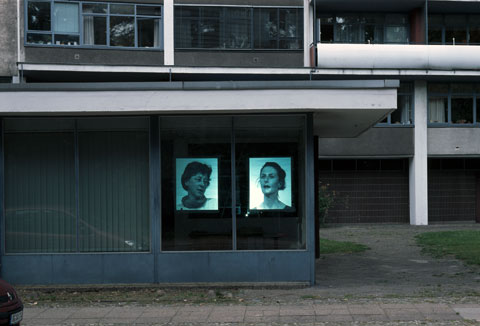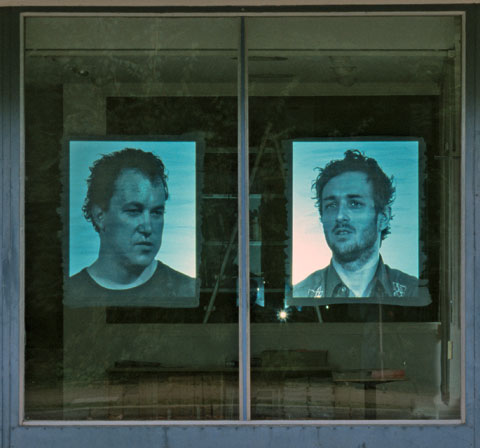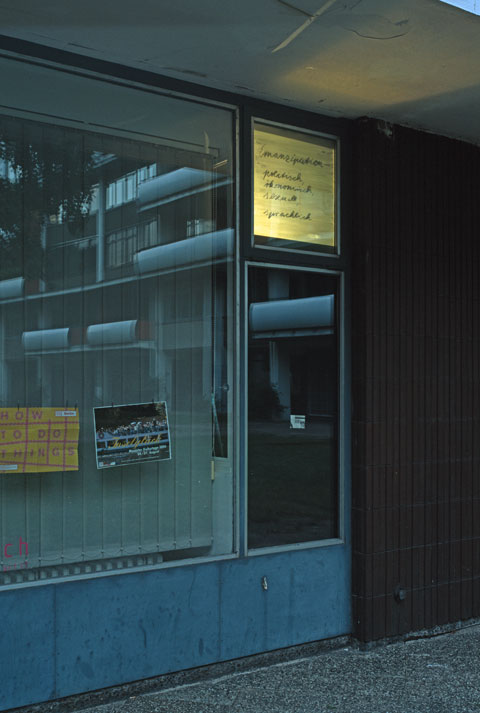Ideals in the Park

Ideale im Park, 2006, Ansicht Filmprojektion, Hansaviertel, Gropius-Pavillon. Präsentiert vom Goldrausch Künstlerinnenprojekt art IT im Rahmen der Moabiter Kulturtage Inselglück in Zusammenarbeit mit dem Kunstverein Tiergarten.
Fotos: Carsten Eisfeld

Ideale im Park, 2006, Ansicht Filmprojektion, Hansaviertel, Gropius-Pavillon. Präsentiert vom Goldrausch Künstlerinnenprojekt art IT im Rahmen der Moabiter Kulturtage Inselglück in Zusammenarbeit mit dem Kunstverein Tiergarten.
Fotos: Carsten Eisfeld

Ideale im Park, 2006, Ansicht Diarojektion, Hansaviertel, Gropius-Pavillon. Präsentiert vom Goldrausch Künstlerinnenprojekt art IT im Rahmen der Moabiter Kulturtage Inselglück in Zusammenarbeit mit dem Kunstverein Tiergarten.
Fotos: Carsten Eisfeld
The stage for this work is the Goldrausch Pavilion, built by Walter Gropius in 1957 as an information centre for prospective tenants. The film ‘Ideals in the Park’ is projected from the within onto the building’s large park-facing windows.
People standing in the park are thus able to see from the outside two moving portraits on the pavilion’s windowpanes. The windows are coated with buttermilk – but not all over, just on two relatively small areas onto which the portraits are projected. People watching the film are thus also able to see the ‘inner life’ of the pavilion at the same time. The buttermilk, which is brushed on, also forms haptic lines that give the projection an additional artistic touch.
At first glance, the format of the portraits fit symmetrically into the architectural structure of Gropius’s window grid. A closer look, however, reveals that two additional upright bars – one of them between the talking characters – have been retrospectively mounted onto the window surfaces.
Slides on a smaller window above and to the right of the pavilion entrance show words such as ‘Love’, ‘Complex and difficult’, ‘Honesty’, ‘Buddhism’ and ‘Emancipation, political, economical, sexual, verbal’. These terms are taken as central themes from the inaudible soundtrack of the diagonally projected film, ‘Ideals in the Park’.
They are written by hand in thick black chalk. Seen together, the slides produced in this way thus have the character of a sketched collection of ideas, spontaneously jotted down.
External presentation
Film projection (loop), buttermilk, HD DV film, black and white, 39 mins 30 secs, no sound, projection size 209 x 157cm, video projector, 1 computer. Metal bars, colour.
Slide projection (loop), buttermilk, 40 Polagraph slides, black and white, projection size 60 x 60cm, 1 Kodak carousel, 1 timer.
Berlin, Hansa Quarter, Gropius Pavilion. Presented by the Goldrausch art IT project for female artists as part of Moabit’s ‘Inselglück’ cultural season in collaboration with the Tiergarten Arts Society.
With special thanks to Birgit Effinger und Hannah Kruse.
Photography copyright Carsten Eisfeld